
Maltipoos, a perfect canine mix of Maltese and Poodle, are adored for their enchanting looks and sweet-loving nature. One of the most fascinating aspects of this hybrid breed is the variety of coat colors they come in.
Maltipoo colors range from those beautiful and classic whites and creams to vibrant reds and apricots, and even striking bi-color and tri-color combinations. Each color has its unique appeal and sometimes hints at the dog's lineage and genetic makeup. Get ready to explore the common and rare Maltipoo colors, the genetics behind these beautiful coats, and how a Maltipoo's color might change over time.
Table of Contents
Common Maltipoo Colors
Maltipoos come in a variety of colors, each with its own unique charm and genetic background. Here’s a detailed look at some common Maltipoo colors, their rarity, and how their colors may change over time:
White Maltipoo
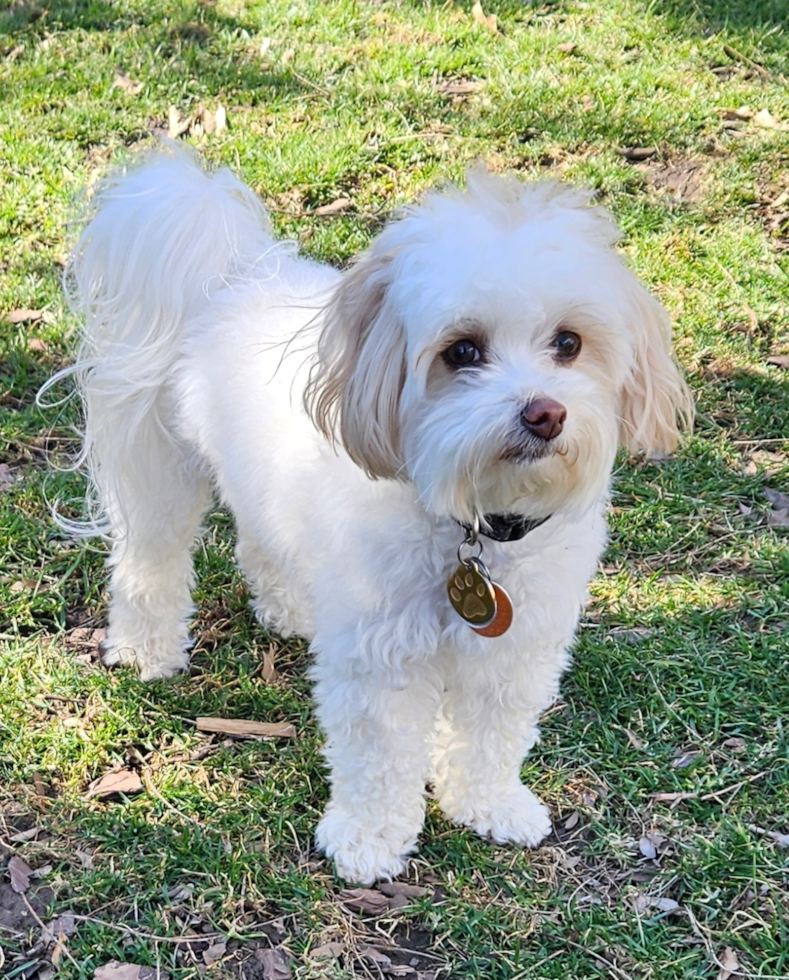
Premier Pups Customer photo of a white Maltipoo
White Maltipoos are one of the most common and easiest colors to breed, thanks to their Maltese heritage. However, their pristine, snow-white fur is prone to discoloration from environmental factors. They can develop a yellowish tinge over time. Regular grooming and the use of high-quality shampoos (made specifically for white coats) can help maintain their bright white appearance.
Cream Maltipoos

Premier Pups Customer photo of a cream Maltipoo
Cream Maltipoos are relatively easy to get and resemble white Maltipoos but with a slightly warmer tone. Their color is stable and does not typically fade or darken significantly over time.
Apricot Maltipoo Color
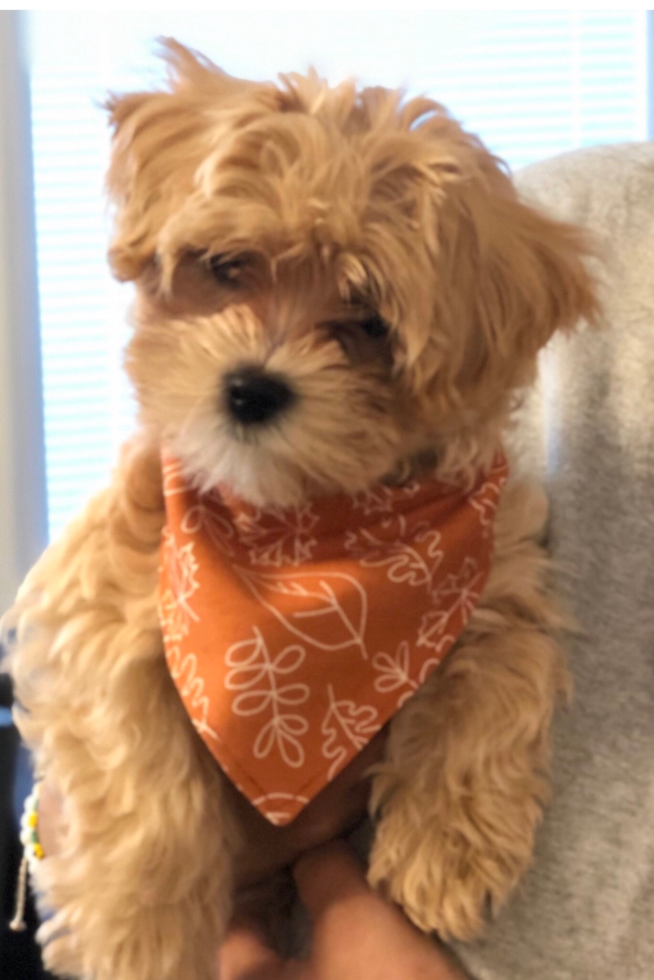
Premier Pups Customer photo of an apricot Maltipoo
Apricot Maltipoos are very popular and are achieved by breeding a white Maltese with a red/apricot Poodle. The apricot color can fade over time. It can lighten to a cream or lighter apricot shade as the Maltipoo dog ages.
Red Maltipoos
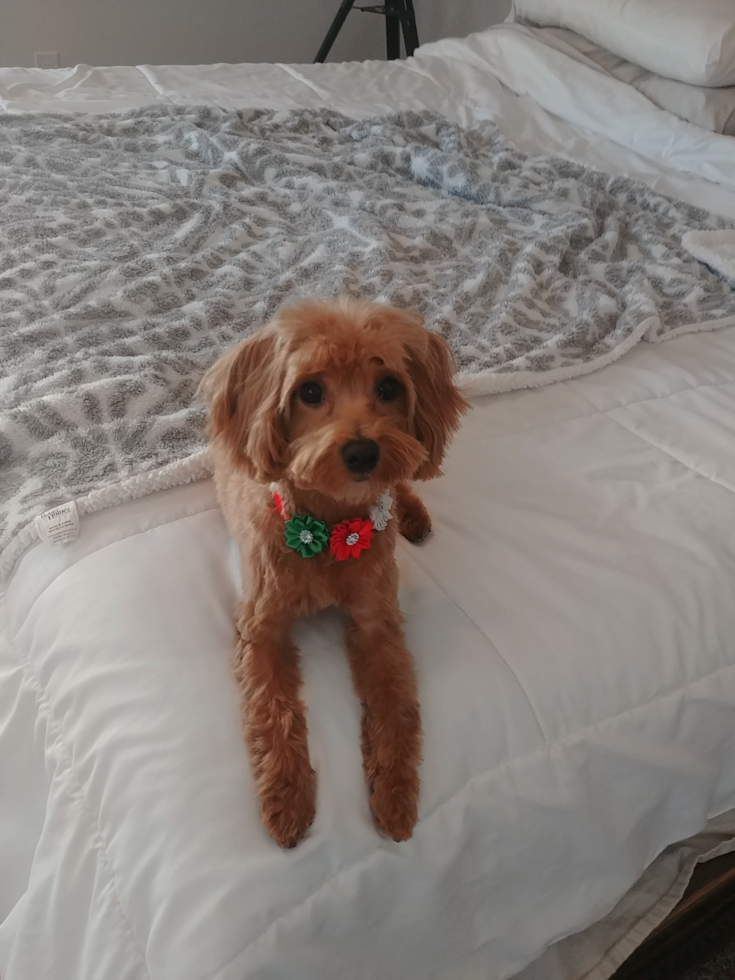
Premier Pups Customer photo of a red Maltipoo
Red Maltipoos are striking and highly sought after, but this color is more challenging to get. The vibrant red coat can and usually does fade with age, turning into a lighter apricot or golden tone. To get a red Maltipoo, one of the Maltipoo’s parents has to have a red coat.
Black Maltipoo
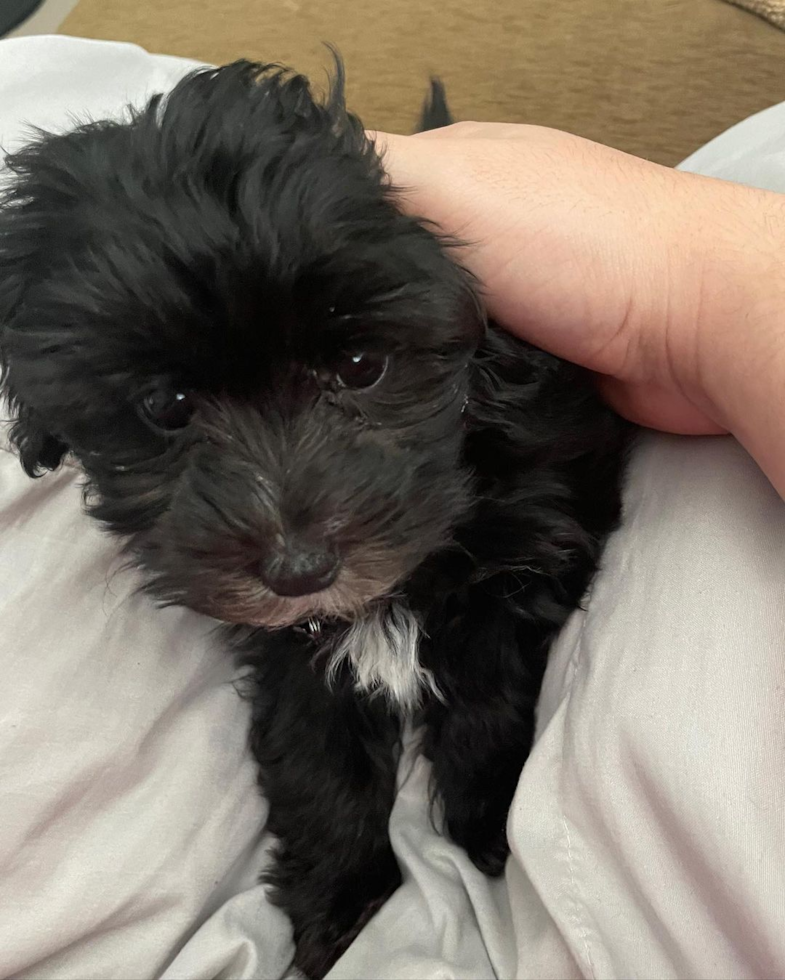
Premier Pups Customer photo of a black Maltipoo
Black Maltipoos are rare and difficult to breed because the color requires both a black Poodle parent and a Maltese that carries the right genes to get that stunning black coloring. Black coats can fade to a darker gray or silver-gray as the dog ages, especially if the black coat comes from recessive genes.
Brown Maltipoo Dogs
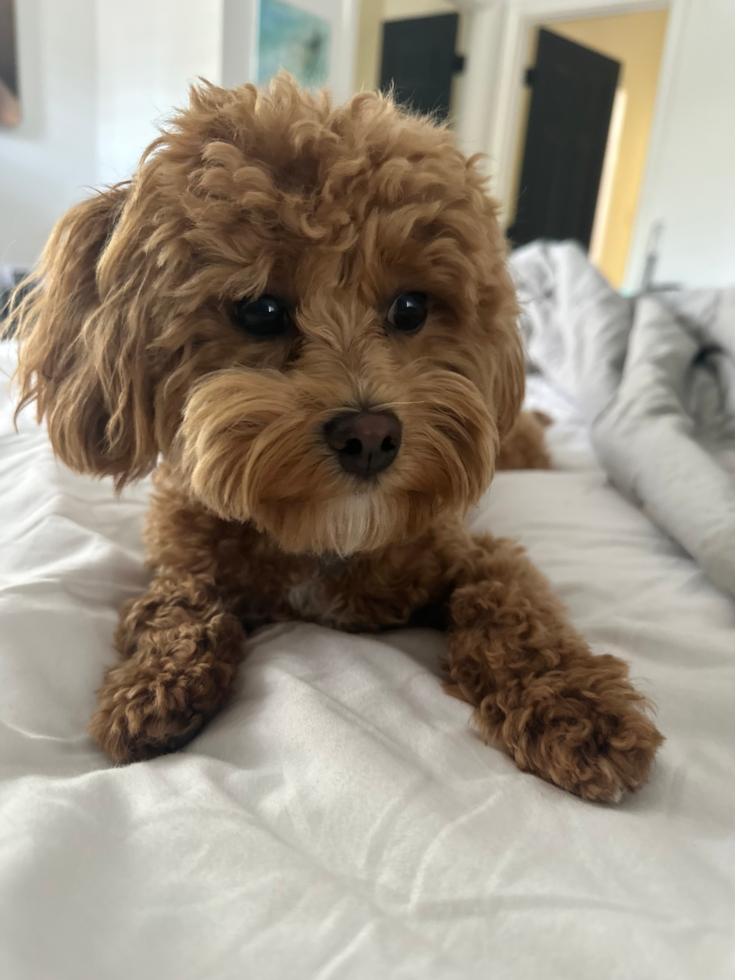
Premier Pups Customer photo of a brown Maltipoo
True brown or chocolate Maltipoos are rare and result from specific genetic combinations. The deep chocolate coloring can be challenging to get and can fade to lighter shades like beige or light coffee as the Maltipoo reaches adulthood.
Gray or Silver Maltipoos
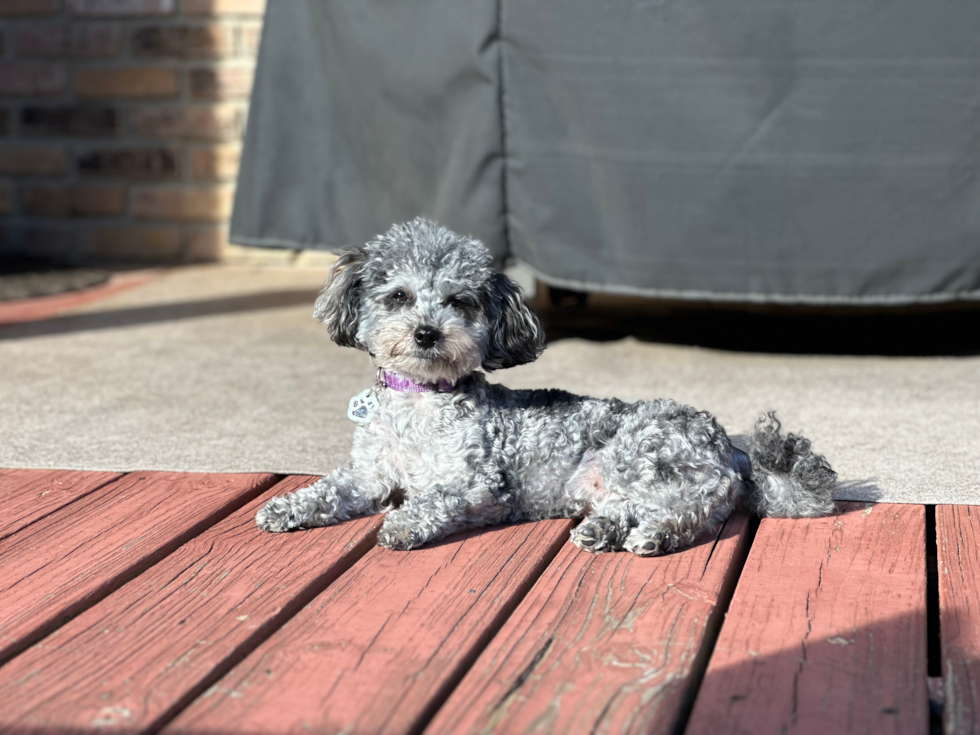
Premier Pups Customer photo of a gray Maltipoo
Gray Maltipoos, also known as silver, are less common and usually start out as a darker shade that lightens with age. This color change is due to the dilution genes inherited from the Poodle parent.
Bi-Color and Tri-Color Combinations in Maltipoos
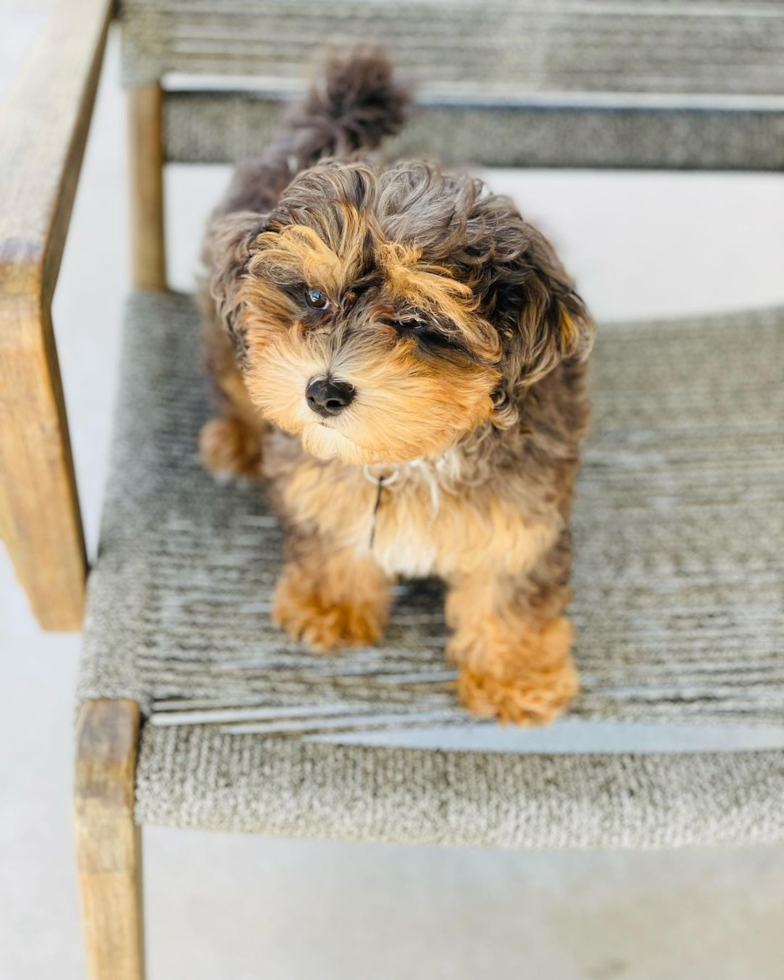
Premier Pups Customer photo of a tricolor Maltipoo
Bi-color and tri-color Maltipoos feature combinations of any of the above colors. For example, a parti Maltipoo has a white base with patches of another color like black, brown, or apricot. These combinations are popular but harder to achieve consistently. Darker colors in these combinations also tend to fade over time.
RELATED: The Forever Young and Sweet Maltipoo
Rare and Unique Maltipoo Colors
Maltipoos can come in a lot of rare and unique colors that are highly prized by enthusiasts. These colors come from specific genetic combinations and can be more challenging to get.
Sable Maltipoo
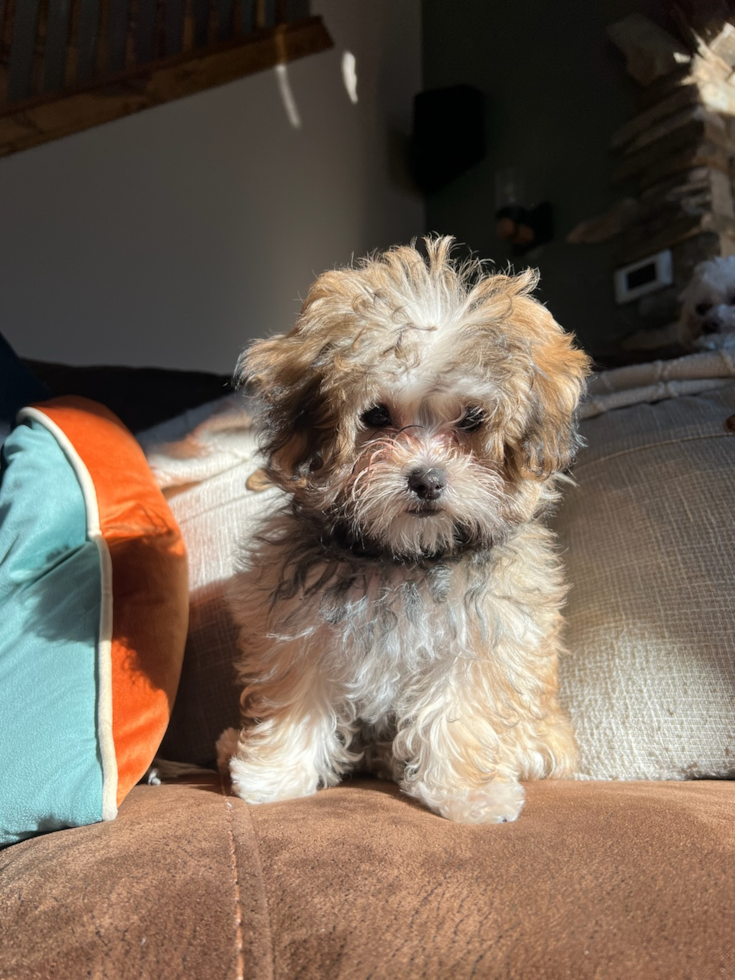
Premier Pups Customer photo of a sable Maltipoo
Sable Maltipoos have a unique coat that features a base color with darker tips. This means each hair is lighter at the root and darker at the tip, creating a beautiful gradient effect. Sable coloring can appear in various shades, including brown, black, and even red. However, the distinctive dark tips may lighten over time as the dog ages, due to the same fading gene that affects other colors.
Phantom Maltipoos
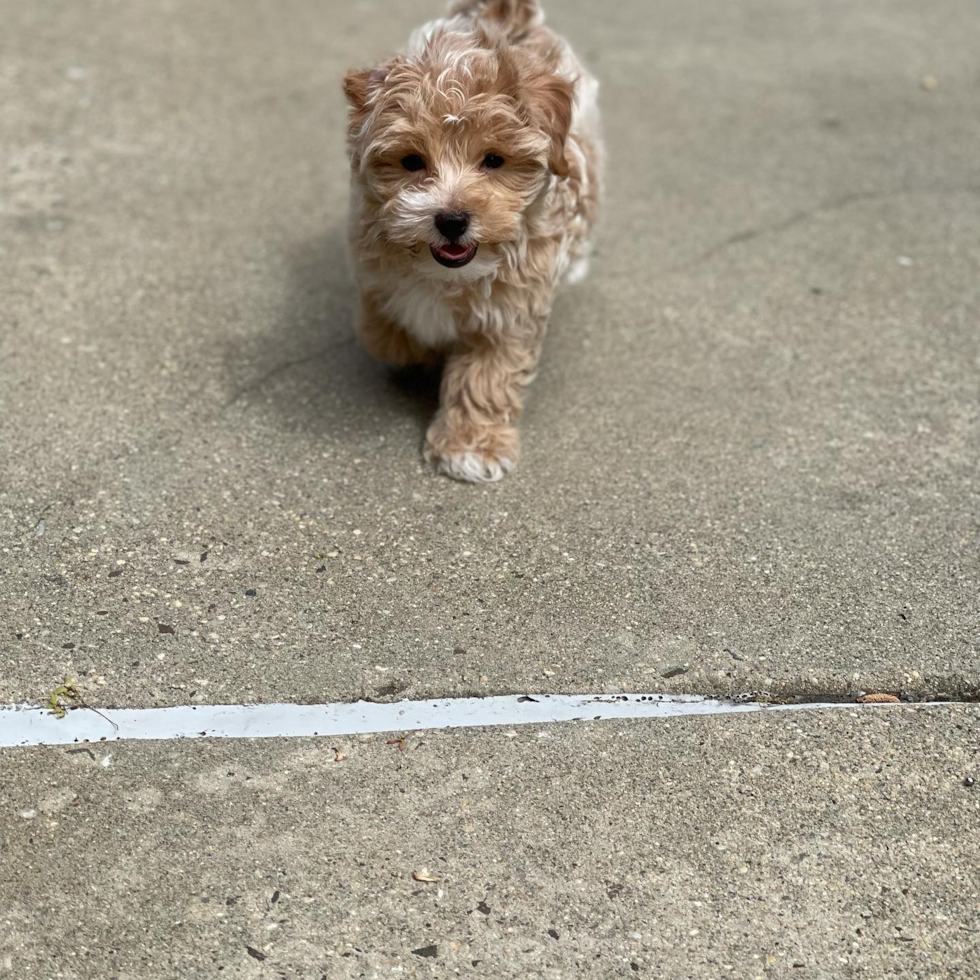
Premier Pups Customer photo of a phantom Maltipoo
Phantom Maltipoos are particularly rare and distinguished by their specific pattern, similar to the phantom coloring seen in Poodles. They have a primary dark color, usually black or brown, with lighter markings above the eyes, on the muzzle, chest, legs, and under the tail. The phantom markings fortunately remain consistent throughout the Maltipoo’s life without significant changes.
Parti Maltipoo
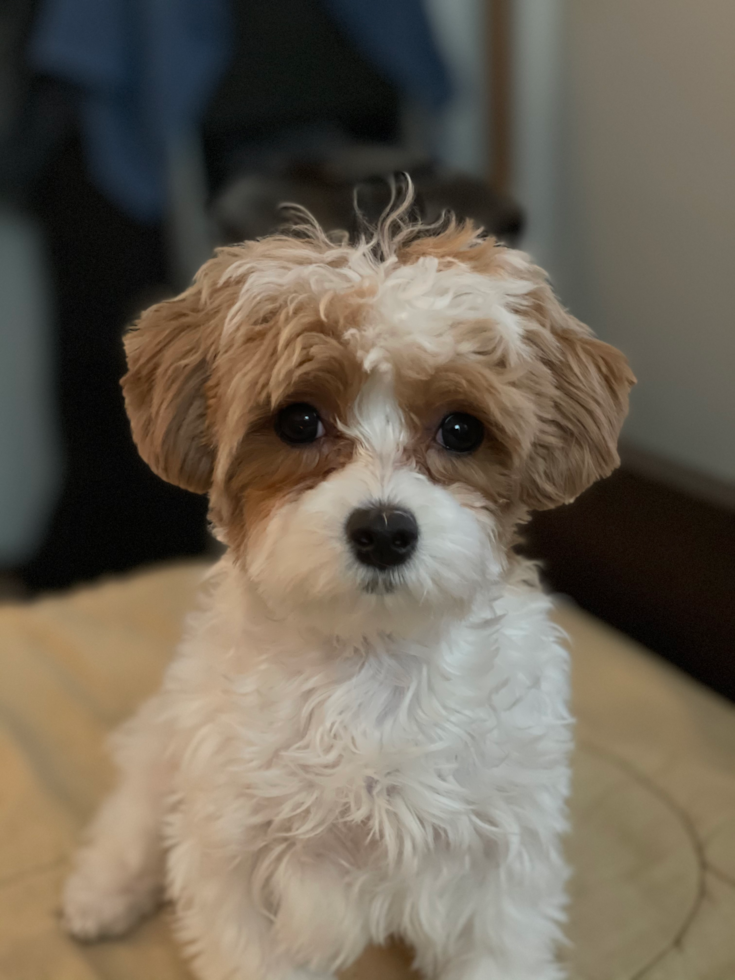
Premier Pups Customer photo of a parti Maltipoo
Parti Maltipoos have a coat that is at least 50% white with patches of another color, such as black, brown, apricot, or cream. The distribution of the patches can vary widely. This coloration requires both parents to carry the parti gene, which makes it relatively rare. The darker patches in parti coats are also subject to fading, often turning to lighter shades as the dog gets older.
Sable Phantom Maltipoo Coloring
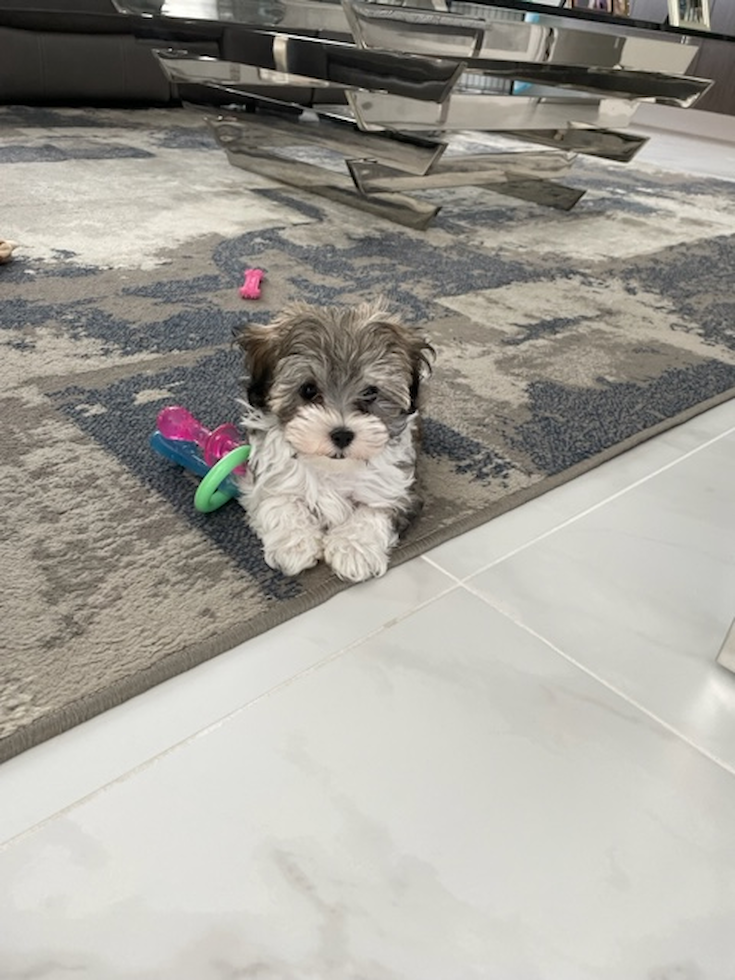
Premier Pups Customer photo of a sable phantom Maltipoo
A sable phantom Maltipoo combines the unique traits of both sable and phantom patterns. This means the dog has a sable base with the characteristic phantom markings. This rare combination creates a stunning and highly unique appearance, with the potential for significant color change as the dog grows older, influenced by the sable and phantom genes.
Genetics of Maltipoo Colors
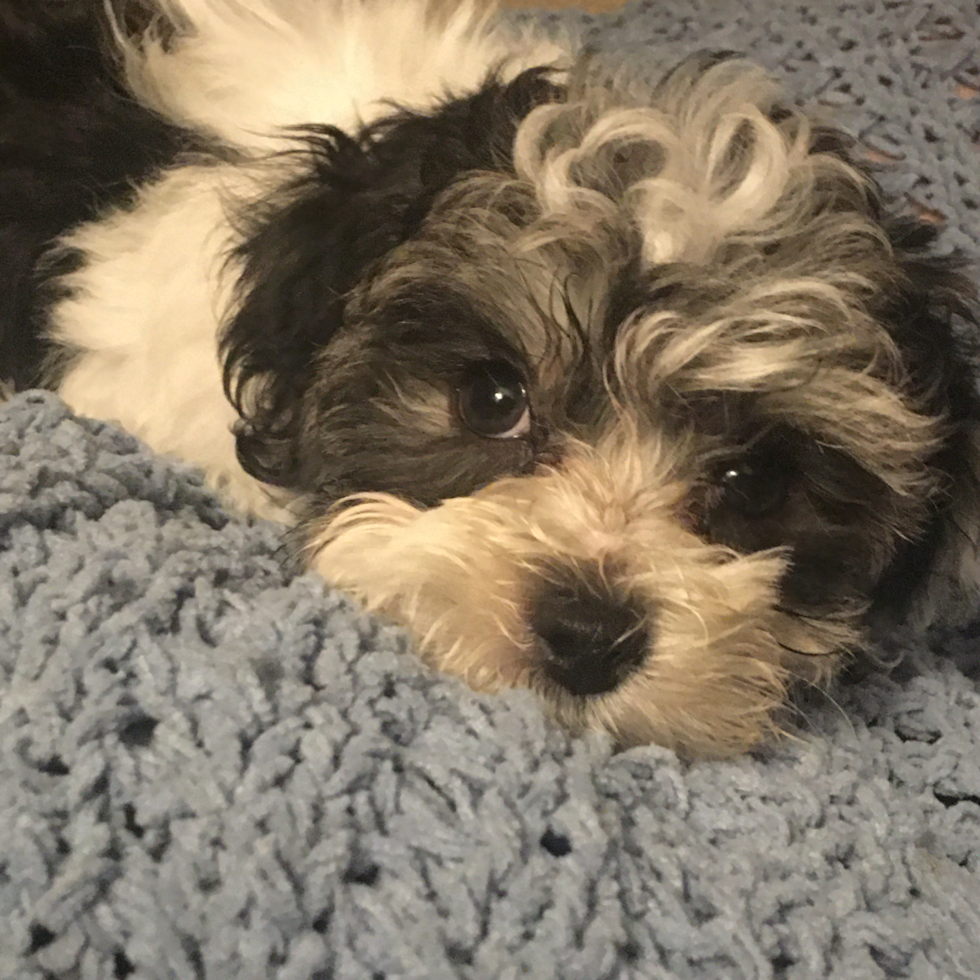
Premier Pups Customer photo of a black and white Maltipoo
Inherited Traits from Parent Breeds
Maltipoos inherit their coat colors from their Poodle and Maltese parents. Sometimes more from one and less from the other. It all depends on the maltipoo’s generation (F1, F1b, F2, etc.). The Poodle contributes significantly to the Maltipoo's color diversity because Poodles come in every color you can think of. The Maltese, traditionally white, also influences the lighter coat colors. Here’s a breakdown of the genetic influences:
Dominant Genes: Colors such as white and cream are easier to achieve due to the dominant genes from the Maltese and lighter-colored Poodles. These colors tend to be more stable and do not change drastically as the dog ages.
Recessive Genes: Darker colors like black and brown are more challenging to breed because they require specific recessive genes from both parents. These genes are less common and often result in coats that may fade to lighter shades over time due to the dilution effect.
Color Changes Over Time
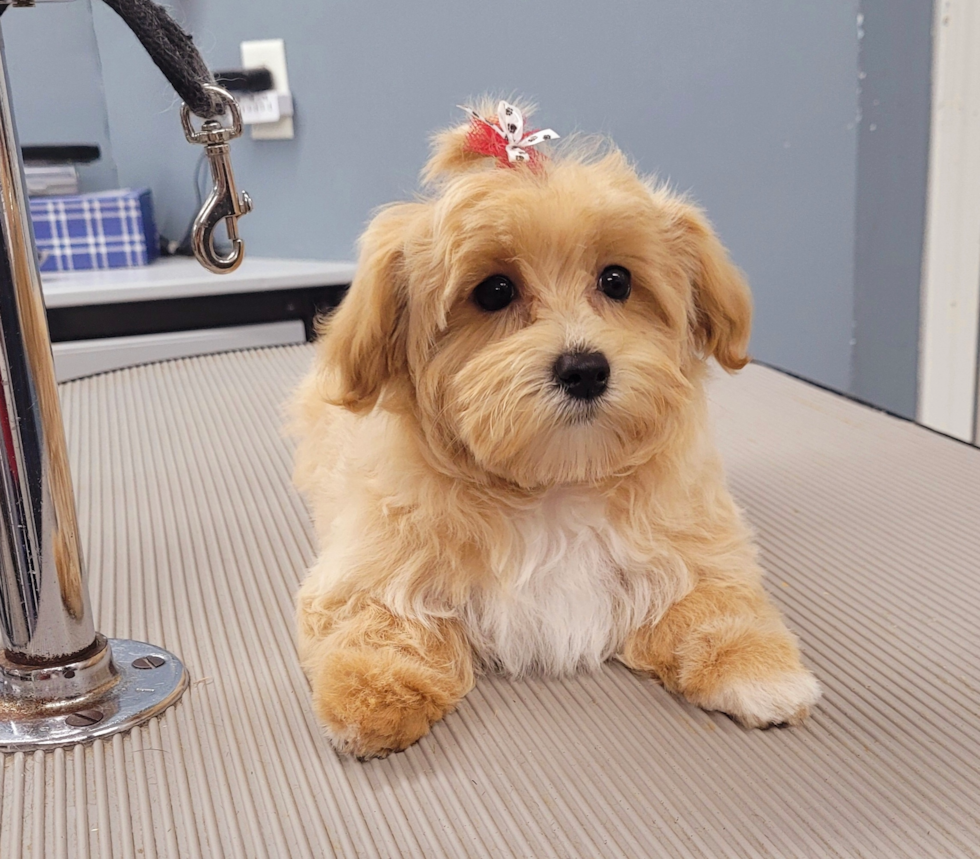
Premier Pups Customer photo of a light-colored Maltipoo
Many Maltipoo colors are subject to change as the dog goes from puppyhood into adulthood. This is primarily due to the fading gene (dilution gene) present in the Poodle lineage. Here are some examples of how colors can change:
- Red and Apricot: These colors can fade to lighter shades such as cream or golden apricot. This fading is gradual and becomes more noticeable as the dog reaches adulthood.
- Black: Black coats fade to silver or gray, especially in dogs that carry the dilution gene. This change can start as early as the puppy stage and continue into adulthood.
- Brown: Brown Maltipoos can lighten to a milk coffee or beige color over time. The deep chocolate brown is particularly susceptible to fading due to the genetic makeup involved in producing this rare color.
RELATED: Everything You Need to Know About Puppy Color Changes
Genetic Testing and Breeding Practices
Breeders can use genetic testing to better predict and achieve desired coat colors in Maltipoos. Knowing the genetic markers that contribute to coat color, breeders can select parent dogs that are more likely to produce puppies with specific colors. This practice helps in maintaining the consistency of rare and popular colors, although it does not eliminate the possibility of color changes.
Choosing a Maltipoo Based on Color
Selecting a Maltipoo based on color involves more than just personal preference. Each color can come with its own set of characteristics and maintenance needs. Here’s what to consider when choosing a Maltipoo based on their coat color:
Personal Preferences and Aesthetics
The first and most obvious consideration is your personal preference. Maltipoos come in a variety of beautiful colors. Whether you prefer the classic look of a white Maltipoo or the striking appearance of a phantom or tricolor, there’s a color to match every taste.
Understanding Color Changes
It’s important to remember that a Maltipoo’s coat color can change over time. Many darker colors, such as black and brown, may fade to lighter shades like silver or beige. If you prefer a specific color, consider how it might change as your puppy grows.
Grooming and Maintenance
Different coat colors can have different grooming requirements. White and cream Maltipoos, for example, are prone to tear staining and may require more frequent cleaning to maintain their pristine appearance. Darker-colored Maltipoos might show less staining but still require regular grooming to keep their coats healthy and vibrant.
Health Considerations
While coat color doesn’t directly affect a Maltipoo’s health, some colors may be linked to specific genetic traits. It’s crucial to choose a reputable breeder who prioritizes health and genetic diversity. This can help ensure that your Maltipoo is healthy, regardless of their coat color.
Price and Availability
Rare and unique colors, such as phantom, sable, and tricolor, can be more expensive due to their rarity and the specific breeding practices required to achieve these colors. If budget is a concern, more common colors like white, cream, and apricot might be more affordable and readily available.
RELATED: See our adorable Maltipoo puppies for sale
Lifestyle and Environment
Consider how your lifestyle and environment might affect your Maltipoo’s coat. For instance, if you live in a sunny area, a darker coat might fade more quickly due to sun exposure. Similarly, if you prefer outdoor activities, a lighter-colored Maltipoo might require more frequent cleaning to stay looking their best.
Care and Maintenance of Maltipoo Coats
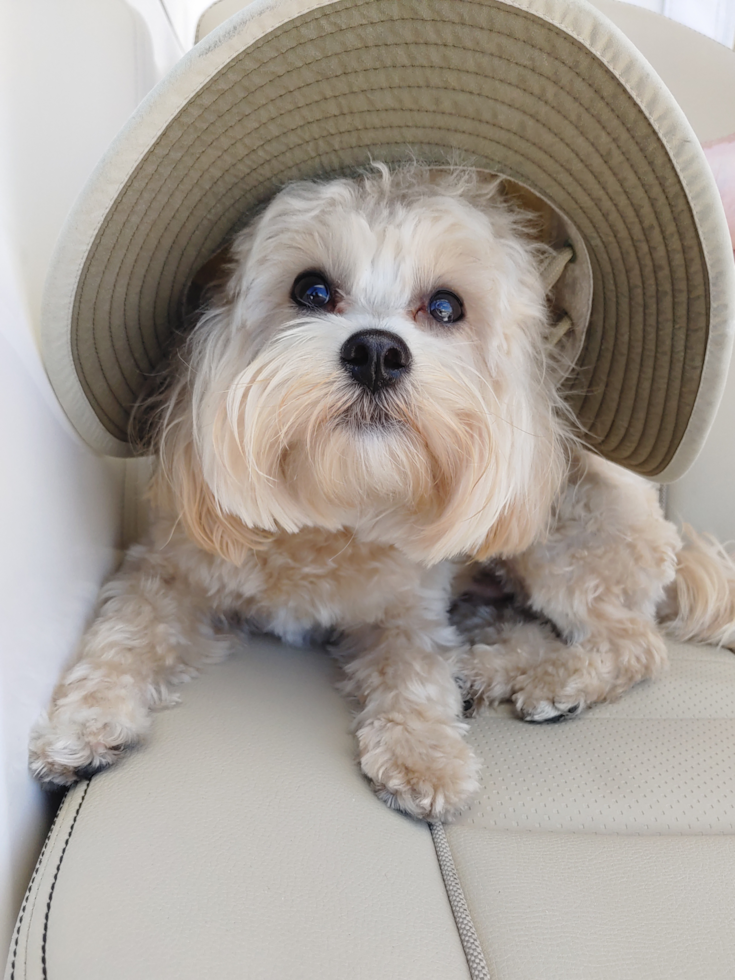
Premier Pups Customer photo of a white and tan Maltipoo
Proper care and maintenance of your Maltipoo’s coat are a must for keeping them looking cute and ensuring they stay health. Here are some tips tailored to different coat colors and types:
Regular Grooming
Regular grooming is crucial for all Maltipoo colors, but it’s especially important for maintaining the coat’s appearance and preventing mats and tangles:
- Brushing: Brush your Maltipoo daily to keep their coat free from tangles and mats. Use a slicker brush or a comb designed for their specific coat type. This is particularly important for longer coats or those prone to matting, such as the curly coats often seen in phantom and sable Maltipoos.
- Bathing: Bathe your Maltipoo every 3-4 weeks, or as needed, using a mild dog shampoo. Avoid over-bathing as it can strip the coat of natural oils, leading to dryness and irritation. For white and cream Maltipoos, use a whitening shampoo to maintain their bright appearance and reduce staining.
- Tear Stain Management: White and cream Maltipoos are prone to tear stains, which can be managed by wiping the area around their eyes daily with a damp cloth and using tear stain removers.
RELATED: Grooming your Dog at Home Guide
Diet and Nutrition
A balanced diet rich in essential nutrients supports overall coat health:
- Omega-3 and Omega-6 Fatty Acids: Include foods or supplements high in these fatty acids to promote a shiny and healthy coat. Fish oil supplements can be particularly beneficial.
- High-Quality Dog Food: Feed your Maltipoo high-quality dog food that meets their nutritional needs. Look for foods with real meat as the first ingredient and avoid fillers and artificial additives. Homemade meals are also a great option!
RELATED: Puppy Feeding 101: A Comprehensive Guide for Raising a Healthy Pup
Sun Protection
Sun exposure can cause the coat colors of Maltipoos, especially darker ones like black and brown, to fade over time.
Limit Sun Exposure. Provide shaded areas when your Maltipoo is outside to protect their coat from UV rays. This helps maintain the richness of darker colors and prevents bleaching.
Professional Grooming
Regular visits to a professional groomer can help maintain the coat’s health and appearance:
- Haircuts: Schedule haircuts every 6-8 weeks to keep the coat at a manageable length and prevent mats. Groomers can also trim around the eyes, paws, and sanitary areas.
- Coat Conditioning: Professional groomers use high-quality conditioners and detanglers that can keep the coat soft and shiny.
RELATED: 20 Pros and Cons of Owning a Maltipoo
Conclusion
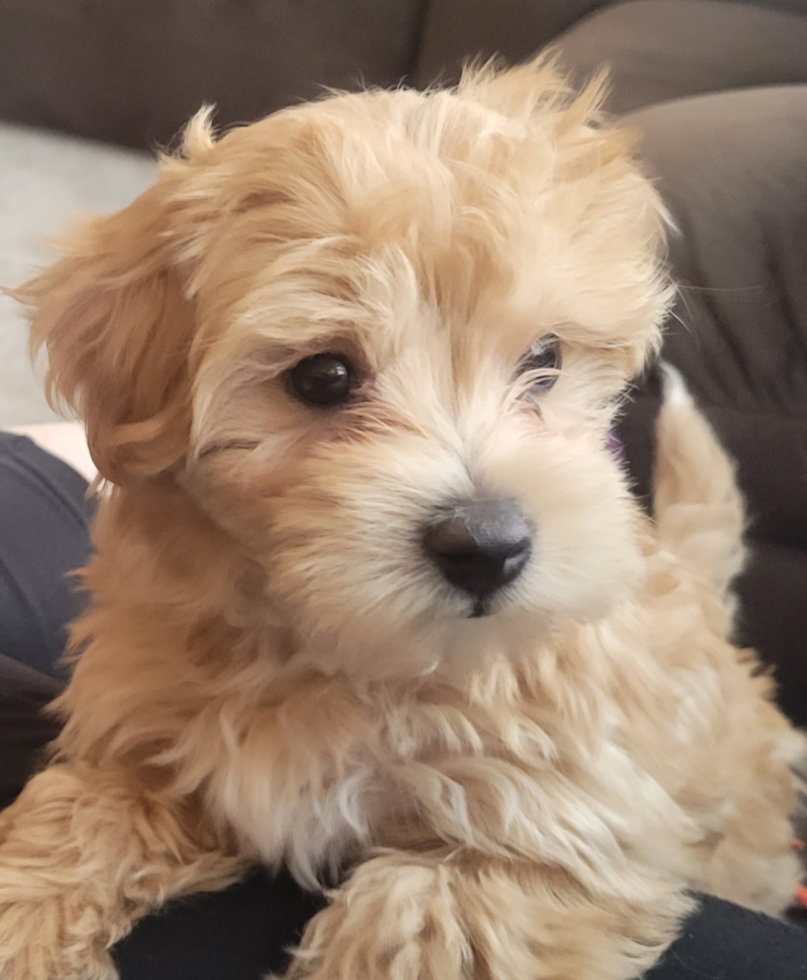
Premier Pups Customer photo of a tan Maltipoo
Maltipoos are a beautiful breed with a lot of stunning coat colors that range from common shades like white, cream, and apricot to rarer hues such as phantom, sable, and chocolate. Once you understand the genetics behind these colors, it can help you appreciate their uniqueness and manage your expectations regarding potential color changes as your Maltipoo matures. No matter their color, Maltipoos are a hit. It’s not only their teddy bear appearance that has enthusiasts on their toes, but that fun-loving, affectionate personality they proudly display.
Scroll down to see FAQs about Maltipoo Colors
What To Read Next
15 Best Dog Breeds for First-Time Owners
Hollywood’s Latest Trend – Doodle Dogs
Frequently Asked Questions
Do Maltipoos change color as they age? Yes, Maltipoos can experience color changes as they grow older, but this doesn’t mean that all of them will. This is particularly common in darker-colored Maltipoos, especially those with black, brown, or red coats. These colors can fade to lighter shades like silver, beige, or cream due to the dilution gene inherited from the Poodle parent. Apricot and red coats may lighten to cream or golden hues.
Why are some Maltipoo colors rarer than others? Certain Maltipoo colors are rarer due to the specific genetic combinations required to produce them. Colors like black, chocolate (brown), and phantom are harder to achieve because they require both parents to carry the appropriate recessive genes.
Are there health issues associated with certain coat colors? While coat color itself does not directly impact a Maltipoo’s health, some genetic factors linked to certain colors can influence health. For example, Maltipoos with lighter coats, particularly white, may be more prone to tear staining.
Can i predict my Maltipoo’s adult coat color? Predicting the adult coat color of a Maltipoo can be challenging due to potential color changes as they grow. However, experienced breeders can often provide insights based on the colors of the parent dogs and their genetic history. Discussing with your breeder about the lineage and any known color changes in previous litters can help set realistic expectations.
What is the most popular Maltipoo color? There is no universally preferred coat color for Maltipoos; it largely depends on personal preference. Each color has its unique charm and appeal. Some people prefer the classic look of a white or cream Maltipoo, while others might be drawn to the rare and striking appearance of a phantom or sable Maltipoo. Ultimately, the best color for you is one that you find most appealing and can manage well in terms of grooming and care.




